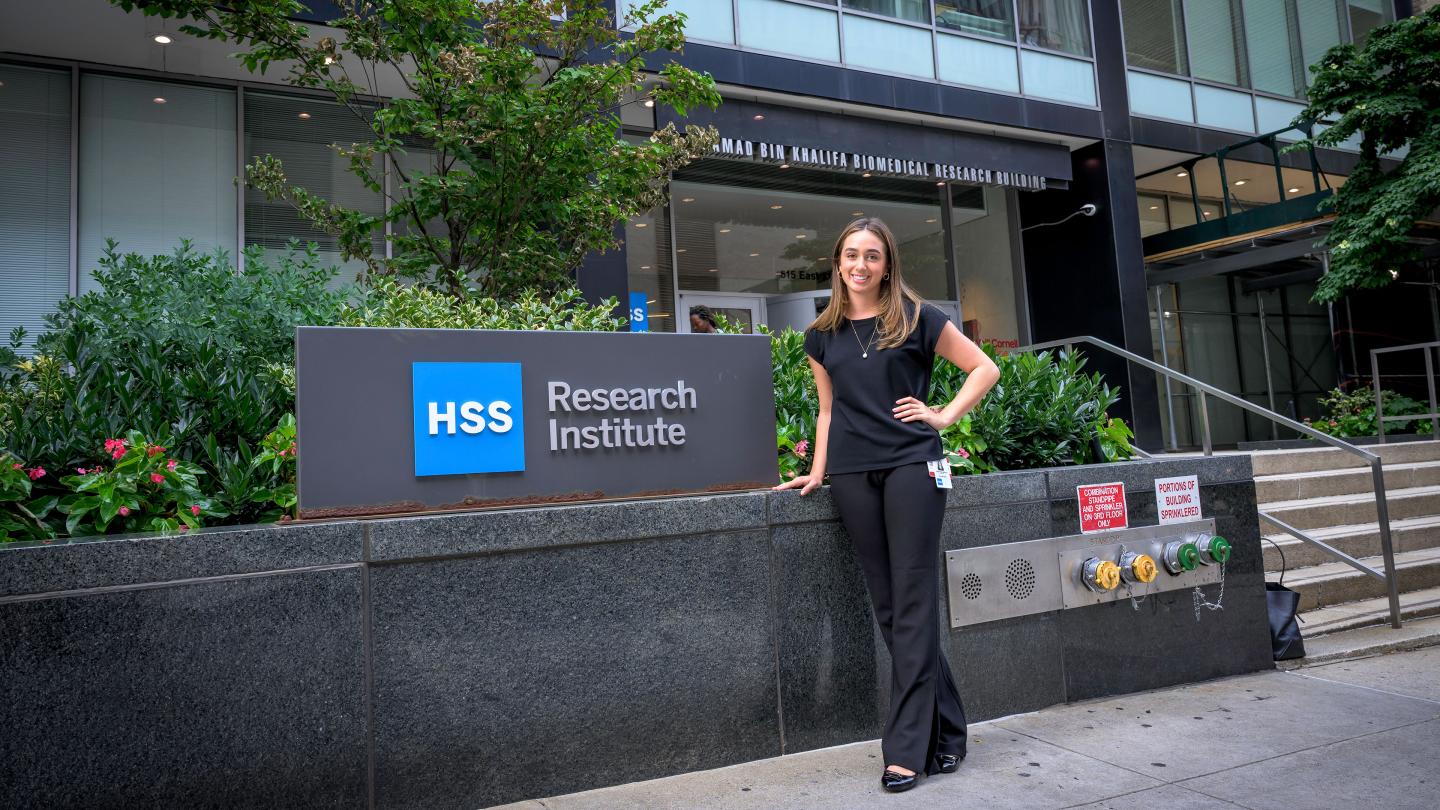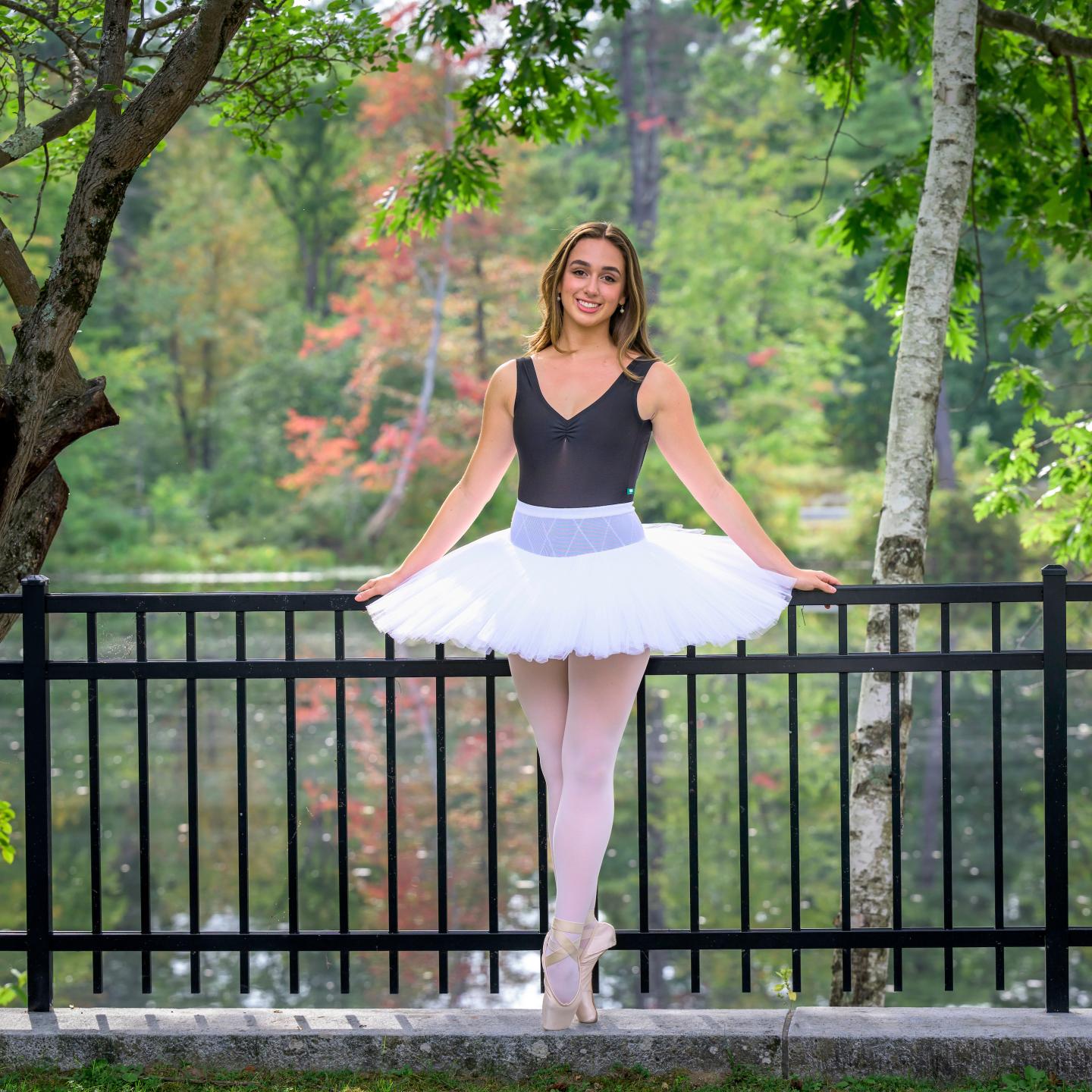

Ballet dancer Cristina Baron ’25 choreographs a career in orthopedic surgery, starting with a summer externship in the lab.
BY KATE DUNLOP
At 5 p.m. on a weekday in mid-July, Cristina Baron ’25 exits the biomedical research building onto a block of Manhattan’s East 71st Street where most pedestrians are sporting either scrubs or some sort of medical accessory — a knee brace, an elbow sling, crutches. Lab credentials swing from her hip, and she looks like a professional researcher — which she is, for six weeks, at the Hospital for Special Surgery’s (HSS) Laboratory for Joint Tissue Repair and Regeneration through her Applied Science and Engineering Program (ASEP) externship.
It’s been a good day, reading papers and analyzing more of the 2,800 mouse knee x-rays for a project on anterior cruciate ligament (ACL) laxity — an effort that will land her name on a published paper. At the same time, she is doing hands-on wet lab work with a medical student on a project using mice to evaluate the role of activated endothelial cells in patellar tendon healing after a tear or tendonitis (the patellar tendon connects the bottom of the kneecap to the top of the shinbone).
In nine years, if all goes according to schedule, she’ll be Dr. Cristina Baron, ready to start her residency in orthopedic surgery, then a fellowship, before becoming an attending doctor by 2040. It’s a plan that began with a childhood dream to be a doctor, though her desire to specialize in orthopedics has come into sharp focus during her time at St. Paul’s School.
A dancer accepted into the SPS Ballet Company, Baron tore her ACL at a summer dance intensive just before her Third Form year. She had surgery at HSS, then another surgery the following spring to remove overgrown scar tissue behind her kneecap that prevented her leg from fully extending — a requirement in ballet. The realization that few orthopedic surgeons offer specialized care for dancers was both a frustration and an inspiration.
“I owe so much to dance,” Baron says. “It’s given me discipline and grit and perseverance and this unquenchable thirst for improvement that I apply to my music as a violinist and to my academics as a student. It’s taught me how to work so, so hard and challenge myself. I won’t be a professional dancer, but I can give back what I owe to the dance world as an orthopedic surgeon.”
As a Fourth Former, Baron returned to the dance studio and stage, but during the spring performance, she tore her other ACL and it was back to HSS. This time, she was in the care of Dr. Scott Rodeo, professor of orthopedic surgery at Weill Medical College of Cornell University and attending surgeon at Hospital for Special Surgery, where his many titles include vice chair of orthopedic research and co-director of the Orthopedic Soft Tissue Research Program, which houses his lab.
“I am eternally grateful to Dr. Rodeo,” Baron says. “He understood what was needed of my knee as a dancer.” At a six-month post-op appointment, she told him about ASEP — how 12 Fifth Form student applicants are accepted into a program that includes a seminar each term before completing a summer externship. As Sixth Formers, ASEP students design and execute a capstone project related to that externship. After reviewing her resume, Dr. Rodeo said he would be happy to have her in his lab even though his team doesn’t usually include high school students.

I owe so much to dance. It’s given me discipline and grit and perseverance and this unquenchable thirst for improvement that I apply to my music as a violinist and to my academics as a student. It’s taught me how to work so, so hard and challenge myself. I won’t be a professional dancer, but I can give back what I owe to the dance world as an orthopedic surgeon.
Baron used her spring term to learn about histology and ways of analyzing data from murine (mouse) models that are often used in orthopedic research, as well as to practice dissecting and observing ligaments and tendons under a microscope. Her New York colleagues — medical and Ph.D. students, professional researchers and even attending surgeons — were surprised by how much she knew when she arrived in June and quickly involved her in their projects. Just three days in, Baron was harvesting mouse tail tendons for culturing. Soon, she was dissecting knees for the tendinopathy project and sectioning and staining tissue samples.
“I had learned about sectioning and staining at school, so it was super cool to do. But so hard,” she says. “I knew science was all trial and error, but I hadn’t experienced that until this summer. Professional research means you’re figuring out what to do next and things fail all the time. And it can be frustrating, but it makes it more rewarding when something works.”
As her time in the lab wound down, Baron was looking ahead to her capstone project at school — since she cannot use mice at SPS, she will use human cells collected from Dr. Rodeo’s surgeries in an in vitro study to test a potential drug for tendinopathy. Taking what she’s learned over the summer, she’s reimagined what’s possible — in the short and the long term.
“I love the idea of my future and have always been excited for what it holds. Now I know I want to make an impact on the lives of athletes and dancers the way that Dr. Rodeo did on mine,” Baron says. “It’ll take a long time, but it will be worth the wait. I can’t imagine doing anything else.”



